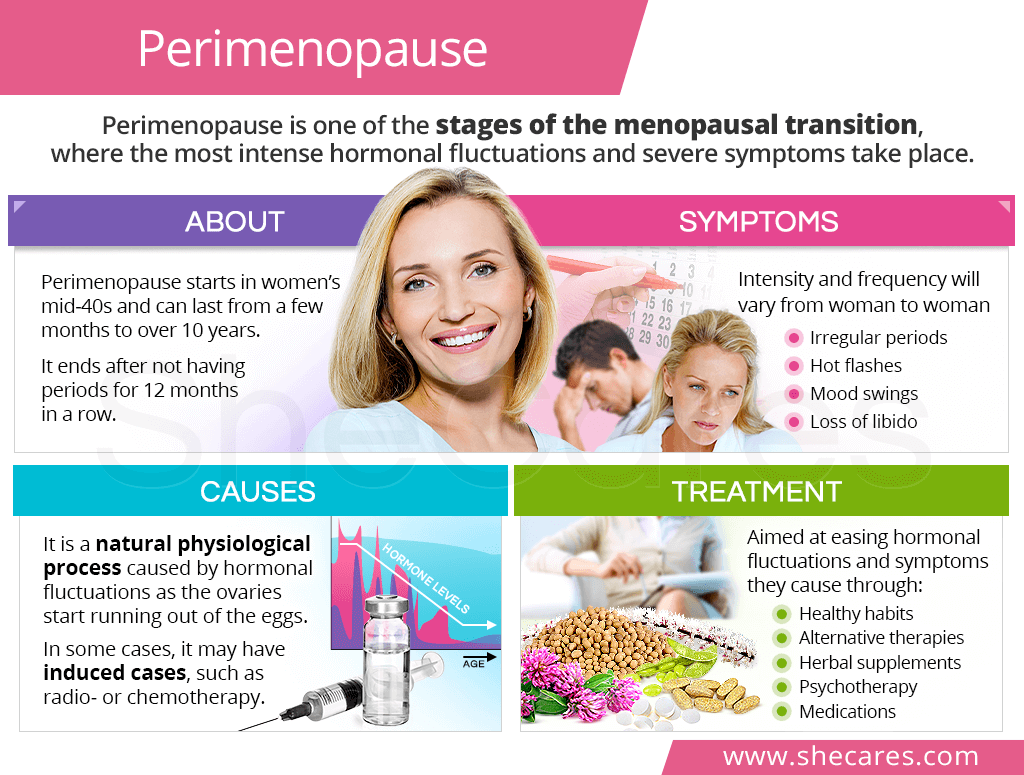What is Perimenopause?
Perimenopause is one of the stages of the menopausal transition. As aforementioned, it is colloquially referred to as menopause. During that stage, women's reproductive functions are not over yet as they still have their periods and can get pregnant.
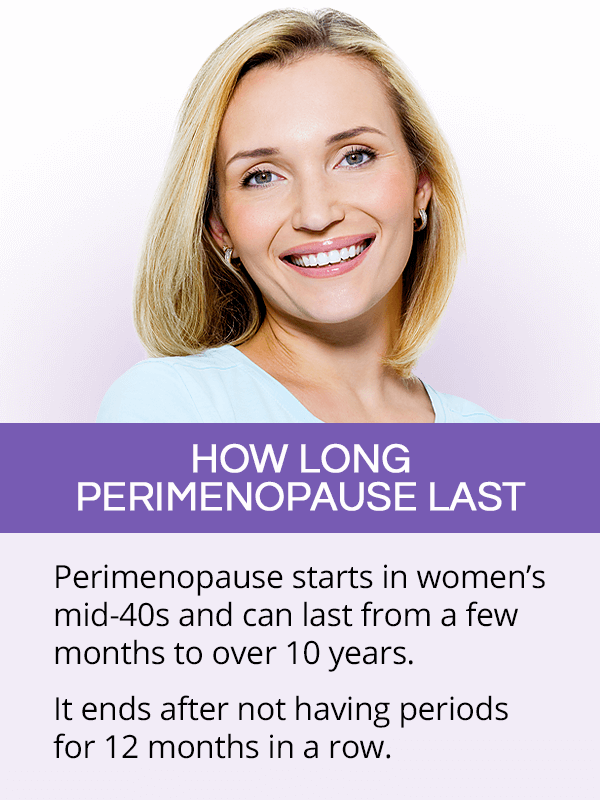
Perimenopause comes after premenopause, which are a woman's prime reproductive years, and before actual menopause, which is a point in time when she did not have a menstrual period for 12 months in a row.1
When Does Perimenopause Start and How Long It Lasts
Perimenopause starts with the onset of the first menopause symptoms, typically in a woman's mid-40s.
How long it last will vary from woman to woman, ranging from a few months to over 10 years in duration, with four years being the average.2
Perimenopause officially ends after a year of not having periods, around the age of 51 on average.3
Perimenopause Causes & Risk Factors
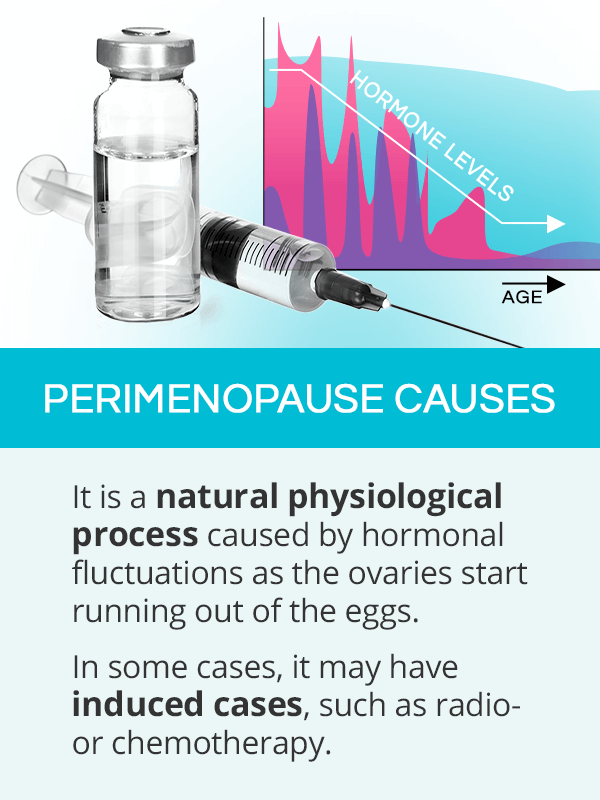
For the majority of women, perimenopause is a natural physiological process, brought about by hormonal fluctuations. In some, however, it can have induced causes.
Natural Causes of Perimenopause
Estrogen and progesterone are the main two hormones that govern the menstrual cycle. They are mainly produced in the ovaries, more specifically - the follicles that surround the eggs that are released on subsequent ovulations.
The number of ovarian eggs, called the ovarian reserve, is defined at birth and decreases at various speeds throughout a woman's life. After 35, that decline becomes faster.4 Typically, by mid-40s, her ovaries begin running out of eggs, triggering massive hormonal fluctuations. Their beginning marks a woman's entry into perimenopause.
Induced Causes of Perimenopause
Some women may experience perimenopause due to induced causes, oftentimes at a younger age than the average. Such instances mainly include undergoing radio- and chemotherapy, which may cause damage to ovaries and halt their function.
As a result, they can experience perimenopause symptoms, but will not necessarily reach menopause, that is, permanently stop having periods. Depending on women's age, induced menopause may sometimes be reversed with time.
It is also worth noting that if a woman undergoes an oophorectomy, a surgical removal of the ovaries, menopause will start immediately, and she will not experience perimenopause. Such instances are referred to as surgical menopause.
Perimenopause Risk Factors
There is no way to know for sure when a woman will enter into perimenopause and reach her final period. However, certain factors make it more likely to begin at a younger age.
They may include family history, chromosomal abnormalities, autoimmune conditions, and smoking, among others.
Signs & Symptoms of Perimenopause
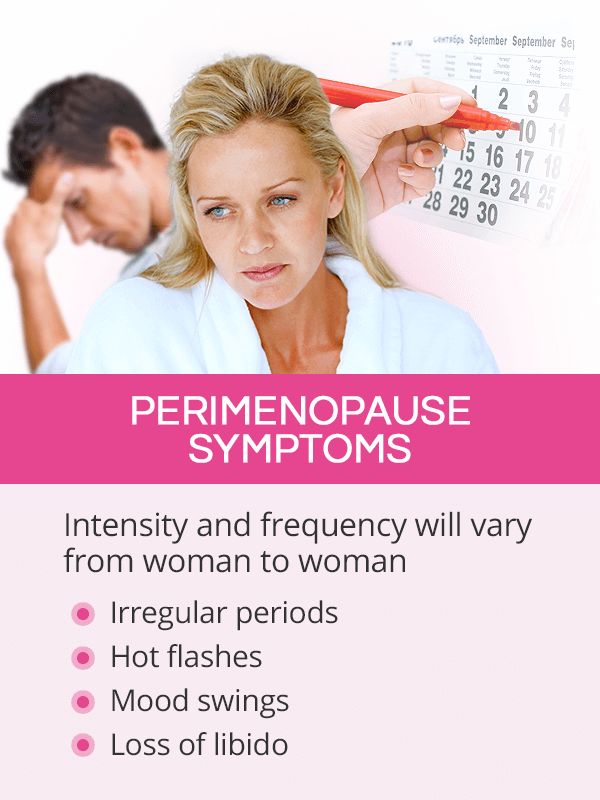
Perimenopause symptoms, usually called menopause symptoms, include a wide range of physical and psychological discomforts that vary in their intensity and frequency.
Perimenopause Symptoms
Most likely, the very first symptom a woman experiences as she enters into perimenopause are changes in her menstrual cycle. Period irregularities can relate to changes in their length, flow, or overall patterns.
Other common perimenopause symptoms women struggle with include, but are not limited to, the following:
Perimenopause Signs
A woman's entry into perimenopause is generally confirmed based on her symptoms, age, and menstrual patterns.
As such, menopause tests to obtain objective perimenopause signs, such as blood estrogen levels or vaginal pH, are not usually ordered at this stage. A doctor may, however, check a woman's thyroid levels to rule other causes of experienced symptoms, such as thyroid disorders.
Perimenopause Treatment
For most women, perimenopause is a long and gradual process. For this reason, it is crucial to choose the right menopause treatment, giving preference to natural options and using caution when moving on to more conventional routes.
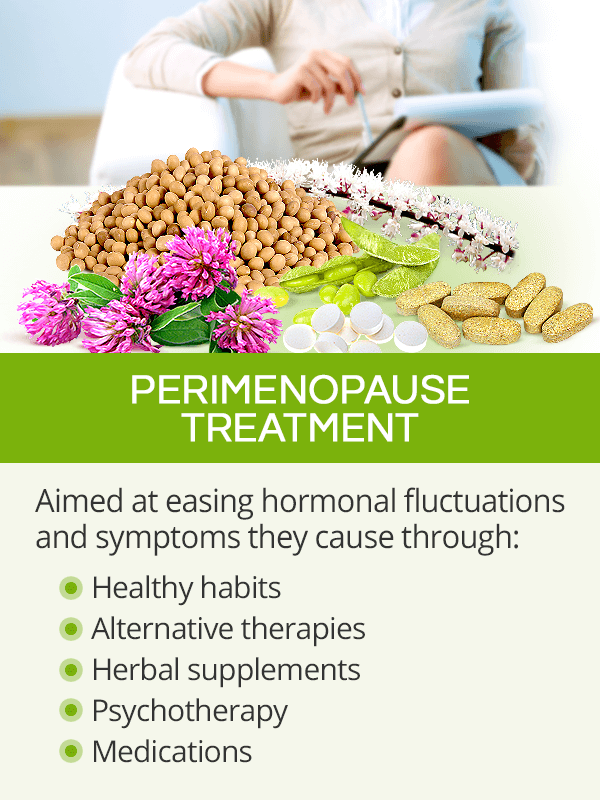
The most commonly used perimenopause treatments include the following:
Healthy Habits
A good approach to easing hormonal imbalance and treating perimenopause symptoms starts by optimizing one's daily choices. It consists of eating a nutritious menopause diet, staying physical active with adequate menopause workouts, avoiding triggers, controlling stress, and others.
Alternative Therapies
Women can also relieve their symptoms and reduce menopause stress with alternative therapies, many of which have been scientifically tested. Some of the best options include acupuncture, aromatherapy, mediation, massage therapy, and more.
Herbs & Natural Supplements
Whether used in infusions or taken as supplements, herbs for menopause are a great option. Phytoestrogenic supplements, like black cohosh, are best for short-term use, while hormone-balancing supplements, like Macafem, can be taken long-term for optimal hormonal nourishment.
Psychotherapy
Cognitive-behavioral therapy (CBT) and other forms of psychotherapy may be especially beneficial for women struggling with emotional symptoms of perimenopause, like depression, irritability, or anxiety. Interestingly, studies have shown that CBT can also help relieve physical discomforts, including hot flashes.5
Medications
The choice of menopause medications will depend on the type and intensity of symptoms, including antidepressants, birth control pills, or analgesics. In the case of severe symptoms, women may be offered hormone replacement therapy (HRT), which - because of associated health risks - should be used with caution.
Key Takeaway
Perimenopause is not easy for most women. This menopause-preceding stage begins in their 40s and can persist for over a decade, plaguing women with uncomfortable symptoms and affecting their quality of life. While known to be bothersome, perimenopause is a natural part of being a woman, caused by a decline of reproductive hormones. During that stage, it is still possible for women to get pregnant, despite the hormonal imbalance and irregular periods. To lessen the effects of hormones on their health, women can choose various perimenopause treatments, ranging from safe, natural options to more conventional routes.
Sources
- American College of Obstetricians and Gynecologists. (2015). The Menopause Years. Retrieved February 18, 2021 from https://www.acog.org/Patients/FAQs/The-Menopause-Years
- Minerva Ginecologica. (2009). Hormone changes associated with the menopausal transition. Retrieved February 18, 2021 from https://www.minervamedica.it/en/journals/minerva-ginecologica/article.php?cod=R09Y2009N06A0483
- North American Menopause Society. (n.d.). Menopause FAQs: Understanding the Symptoms. Retrieved February 18, 2021 from https://www.menopause.org/for-women/expert-answers-to-frequently-asked-questions-about-menopause/menopause-faqs-understanding-the-symptoms
- Office on Women's Health. (2018). Menopause. Retrieved February 18, 2021 from https://www.womenshealth.gov/menopause/
- Penn Medicine. (2016). The Change Before the Change: 9 Questions About Perimenopause. Retrieved February 18, 2021 from https://www.pennmedicine.org/updates/blogs/womens-health/2016/december/the-change-before-the-change
- US Food & Drug Administration. (2018). Menopause. Retrieved February 18, 2021 from https://www.fda.gov/ForConsumers/ByAudience/ForWomen/WomensHealthTopics/ucm117978.htm
- Women's Health Research Institute. (n.d.). How Hormones Depletion Affects You. Retrieved February 18, 2021 from http://menopause.northwestern.edu/content/how-hormone-depletion-affects-you
Footnotes:
- Cleveland Clinic. (2019). Menopause, Perimenopause and Postmenopause. Retrieved February 18, 2021 from https://my.clevelandclinic.org/health/diseases/15224-menopause-perimenopause-and-postmenopause
- Harvard Health Publishing. (2020). Perimenopause: Rocky road to menopause. Retrieved February 18, 2021 from https://www.health.harvard.edu/womens-health/perimenopause-rocky-road-to-menopause
- Mayo Clinic. (2020). Menopause. Retrieved February 18, 2021 from https://www.mayoclinic.org/diseases-conditions/menopause/symptoms-causes/syc-20353397
- The American Society for Reproductive Medicine. (n.d.). Age and Fertility. Retrieved February 18, 2021 from https://www.reproductivefacts.org/news-and-publications/patient-fact-sheets-and-booklets/documents/fact-sheets-and-info-booklets/age-and-fertility/
- Menopause. (2019). Cognitive behavior therapy for menopausal symptoms (CBT-Meno): a randomized controlled trial. Retrieved November 23, 2020 from https://journals.lww.com/menopausejournal/Abstract/2019/09000/Cognitive_behavior_therapy_for_menopausal_symptoms.6.aspx
